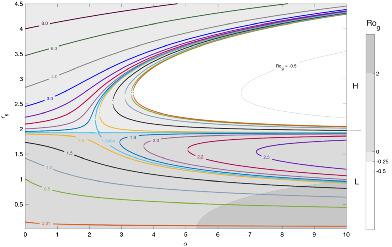当前位置:
X-MOL 学术
›
Q. J. R. Meteorol. Soc.
›
论文详情
Our official English website, www.x-mol.net, welcomes your
feedback! (Note: you will need to create a separate account there.)
Lagrangian trajectories at the outflow of tropical cyclones
Quarterly Journal of the Royal Meteorological Society ( IF 3.0 ) Pub Date : 2020-09-09 , DOI: 10.1002/qj.3904 Yair Cohen 1 , Nathan Paldor 2
Quarterly Journal of the Royal Meteorological Society ( IF 3.0 ) Pub Date : 2020-09-09 , DOI: 10.1002/qj.3904 Yair Cohen 1 , Nathan Paldor 2
Affiliation

|
Recent observations from the upper levels of tropical cyclones show the development of a Low engulfed by a larger High. The impact of such a geopotential map on the dynamics of the outflow is studied by analysing the Lagrangian trajectories of air parcels. The geopotential is modelled by the hydrostatic sum of two, oppositely signed, Gaussians: a warm core and a near‐surface low that together reproduce the relevant features of the observed tropical cyclones. Assuming a time‐independent and axisymmetric geopotential map, the dynamics is described by an integrable, two degrees‐of‐freedom, angular momentum conserving, Hamiltonian system with a single non‐dimensional parameter. The steady states of this system bifurcate when the geopotential amplitude increases above a threshold where the single elliptic fixed‐point becomes hyperbolic surrounded by a pair of elliptic fixed‐points. A gradient balance prevails near the elliptic points while an inertial balance occurs at the radius of maximum geopotential, where the hyperbolic (unstable) point is located. The divergence of trajectories around this hyperbolic point implies the existence of strong horizontal wind divergence. A gradient non‐balance region emerges in the steady state (radius, geopotential amplitude) map and this region expands with the increase of geopotential amplitude which implies that higher angular momentum values are required for trajectories to transition from high to low. A transformation of the (radius, radial velocity) variables to action‐angle variables yields an approximate expression for the tangential drift (long‐time average of the tangential speed) that estimates the tangential winds. The analysis is extended numerically to the case of warm core offset, where the two Gaussians have different centres.
中文翻译:

热带气旋流出时的拉格朗日轨迹
来自热带气旋高层的最新观测表明,低空的发展被较大的高空吞没。通过分析空气包裹的拉格朗日轨迹,研究了这种地势图对流出动力学的影响。地势由两个相反符号的高斯流体静力学总和模拟:一个温暖的岩心和一个近地表低点,它们共同再现了观测到的热带气旋的相关特征。假设一个时间独立且轴对称的地势图,通过一个具有单个无量纲参数的可积分,两自由度,角动量守恒的哈密顿系统描述动力学。当地势振幅增加到阈值以上时,该系统的稳态分叉,在该阈值处单个椭圆形固定点变为双曲线,并被一对椭圆形固定点包围。在椭圆点附近占主导地位的是梯度平衡,而在双曲线(不稳定)点所在的最大地势半径处则发生惯性平衡。围绕该双曲点的轨迹发散意味着存在强烈的水平风发散。稳态(半径,地势振幅)图上会出现一个梯度非平衡区域,该区域会随着地势振幅的增加而扩展,这意味着从高到低的轨迹需要更高的角动量值。(半径,径向速度)变量到动作角度变量会产生一个近似的表达式,表示切向漂移(切向速度的长期平均值),用于估计切向风。该分析将数值扩展到暖心偏移的情况,其中两个高斯人的中心不同。
更新日期:2020-09-09
中文翻译:

热带气旋流出时的拉格朗日轨迹
来自热带气旋高层的最新观测表明,低空的发展被较大的高空吞没。通过分析空气包裹的拉格朗日轨迹,研究了这种地势图对流出动力学的影响。地势由两个相反符号的高斯流体静力学总和模拟:一个温暖的岩心和一个近地表低点,它们共同再现了观测到的热带气旋的相关特征。假设一个时间独立且轴对称的地势图,通过一个具有单个无量纲参数的可积分,两自由度,角动量守恒的哈密顿系统描述动力学。当地势振幅增加到阈值以上时,该系统的稳态分叉,在该阈值处单个椭圆形固定点变为双曲线,并被一对椭圆形固定点包围。在椭圆点附近占主导地位的是梯度平衡,而在双曲线(不稳定)点所在的最大地势半径处则发生惯性平衡。围绕该双曲点的轨迹发散意味着存在强烈的水平风发散。稳态(半径,地势振幅)图上会出现一个梯度非平衡区域,该区域会随着地势振幅的增加而扩展,这意味着从高到低的轨迹需要更高的角动量值。(半径,径向速度)变量到动作角度变量会产生一个近似的表达式,表示切向漂移(切向速度的长期平均值),用于估计切向风。该分析将数值扩展到暖心偏移的情况,其中两个高斯人的中心不同。











































 京公网安备 11010802027423号
京公网安备 11010802027423号